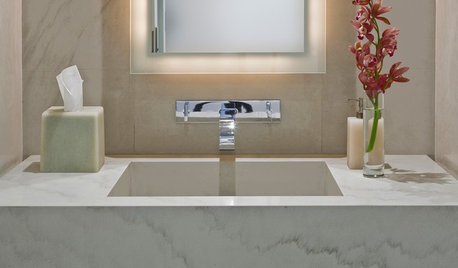water treatment options
zver11
12 years ago
Related Stories

BATHROOM DESIGNGreen and Clean: Sleek Water-Wise Bathroom Fixtures
By choosing ecofriendly faucets, showerheads and even toilets, you can save loads of water and money without sacrificing style
Full Story
LANDSCAPE DESIGNGet Along With Less Lawn — Ideas to Save Water and Effort
Ditch the mower and lower your water bill while creating a feast for the eyes with diverse plantings and gathering places
Full Story
GREEN BUILDINGWater Sense for Big Savings
Keep dollars in your pocket and preserve a precious resource with these easy DIY strategies
Full Story
HEALTHY HOMEHow to Choose a Home Water Filtering System
Learn which water purification method is best for your house, from pitchers to whole-house setups
Full Story
LIFEThe Top 5 Ways to Save Water at Home
Get on the fast track to preserving a valuable resource and saving money too with these smart, effective strategies
Full Story
VACATION HOMESA New Prefab Floating Home: Just Add Water
With Friday’s FloatWing prefabricated modular units, life on a boat just got a little easier
Full Story
WINDOW TREATMENTSHow Low Should Your Drapes Go?
Hover, brush the floor or pool like Scarlett O'Hara's tears — we give you the lowdown on curtain length options
Full Story
WINDOW TREATMENTSHow to Choose the Right Window Blinds
Get the privacy, light filtering and look you want with this breakdown of blind options
Full Story
WINDOWSHow to Dress Tall Windows
Get the right mix of light, shade, privacy and style for towering windows by exploring these coverage options
Full Story
WINDOW TREATMENTSBedroom Window Treatments to Block the Light
Sleep tight with curtains, shades and more designed to keep out bright rays while letting stylishness in
Full StorySponsored
More Discussions









User
User
Related Professionals
Andover Kitchen & Bathroom Remodelers · Auburn Kitchen & Bathroom Remodelers · Centerville Kitchen & Bathroom Remodelers · Elk Grove Kitchen & Bathroom Remodelers · Fair Oaks Kitchen & Bathroom Remodelers · Glendale Kitchen & Bathroom Remodelers · Hunters Creek Kitchen & Bathroom Remodelers · Overland Park Kitchen & Bathroom Remodelers · Saint Augustine Kitchen & Bathroom Remodelers · San Juan Capistrano Kitchen & Bathroom Remodelers · Skokie Kitchen & Bathroom Remodelers · Spokane Kitchen & Bathroom Remodelers · Tempe Kitchen & Bathroom Remodelers · Terrell Kitchen & Bathroom Remodelers · Fairmont Kitchen & Bathroom Remodelerszver11Original Author
zver11Original Author
User
User